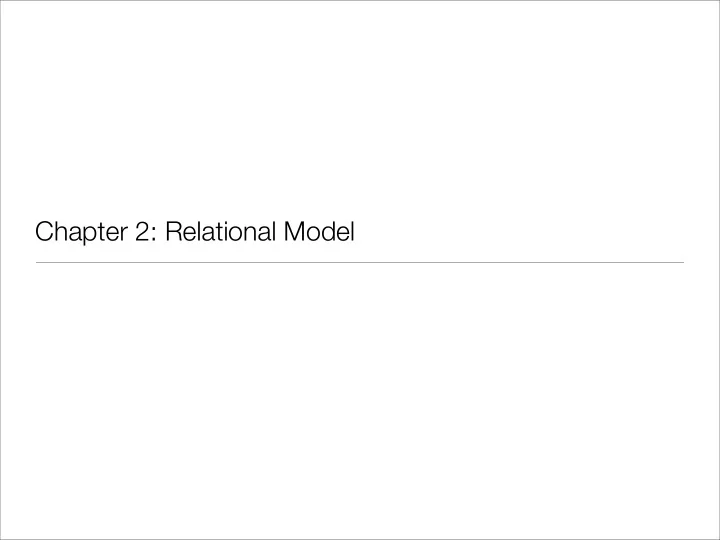

Chapter 2: Relational Model
Chapter 2: Relational Model • Structure of Relational Databases • Fundamental Relational-Algebra Operations • Additional Relational-Algebra Operations • Extended Relational-Algebra Operations • Null Values • Modification of the Database
Example of a Relation
Attribute Types • Each attribute of a relation has a name • Set of allowed values: domain of the attribute • Values (normally) required to be atomic; • indivisible • e.g., Downtown , but not {Downtown, Mianus} • Domain is said to be atomic if all its members are atomic • Special value null : member of every domain • unknown or non-existent value • The null value causes complications in the definition of many operations • We shall ignore the effect of null values in our main presentation and consider their effect later 4
Domains and Tuples • Domain D 1 : set of all account numbers, similarly D 2 , D 3 • Every row: tuple of 3 values ( v 1 , v 2 , v 3 ) • Table account � all such tuples
Relation Schema • Given domains D 1 , D 2 , …. D n a relation r is a subset of D 1 x D 2 x … x D n ( cartesian product ) Thus, a relation is a set of tuples (a1, a2, …, an) Tuple Row where each ai � Di Relation Table • Schema of a relation consists of General Math • attribute definitions • name • type/domain • integrity constraints
Schema and Relations Account_schema = (account_number, branch_name, balance) Schema account(Account_schema) Relation from a schema Relation instance
⇒ Relation Instance • The current values (relation instance) of a relation are specified by a table • An element t of r is a tuple, represented by a row in a table • Order of tuples is irrelevant (tuples may be stored in an arbitrary order) attributes (or columns) customer_city customer_name customer_street Jones Main Harrison tuples Smith North Rye (or rows) Curry North Rye Lindsay Park Pittsfield Customer t[customer_name] = t[1] = Jones t
Database • A database consists of multiple relations • Information about an enterprise is broken up into parts, with each relation storing one part of the information • E.g. account : information about accounts � � depositor : which customer owns which account customer : information about customers
The customer Relation Customer_schema = (customer_name, customer_street, customer_city)
The depositor Relation Depositor_schema = (customer_name, account_number)
Why Split Information Across Relations? • Storing all information as a single relation such as Bank_schema = (account_number, balance, customer_name, ..) • Results in • repetition of information • e.g.,if two customers own an account (What gets repeated?) • the need for null values • e.g., to represent a customer without an account • Normalization theory (Chapter 7) deals with how to design relational schemas
Recommend
More recommend